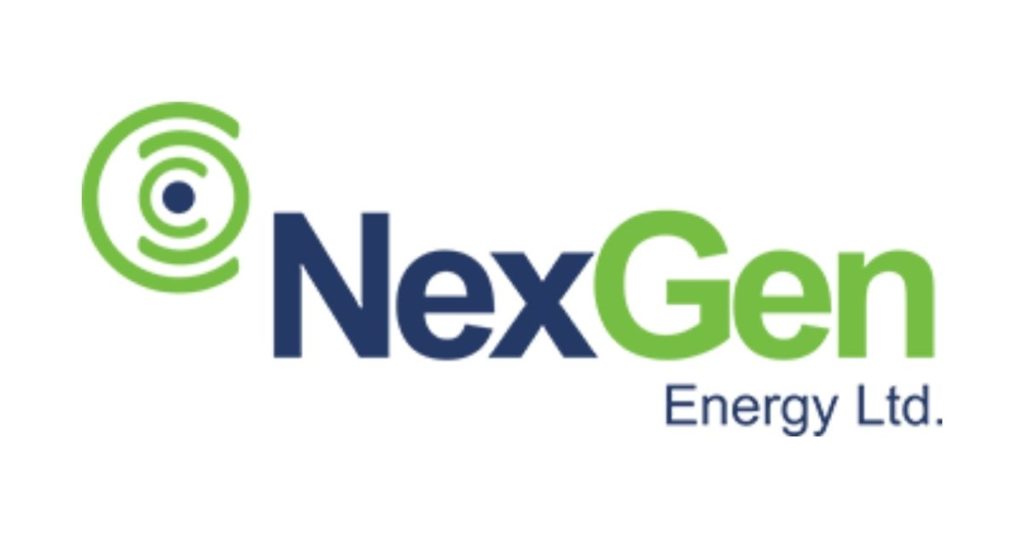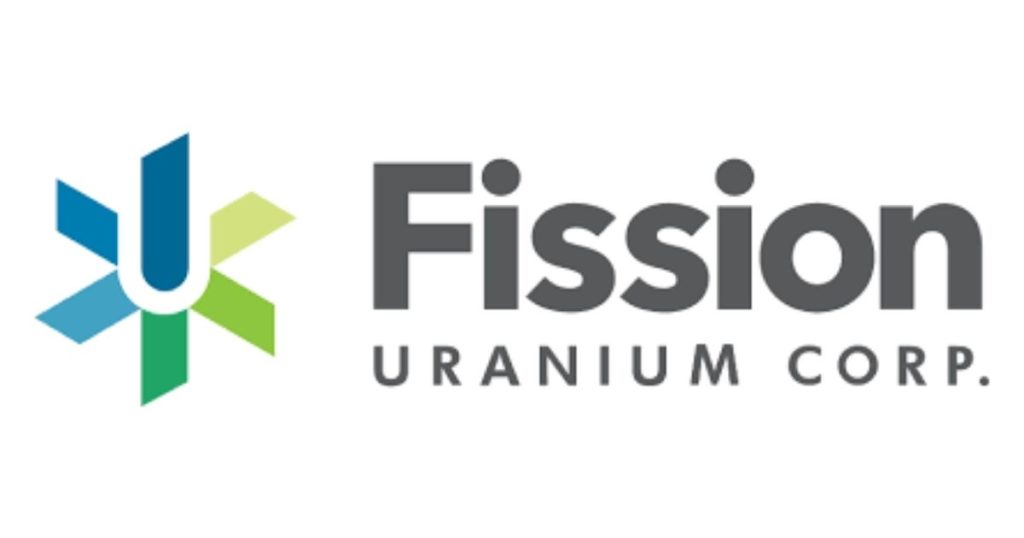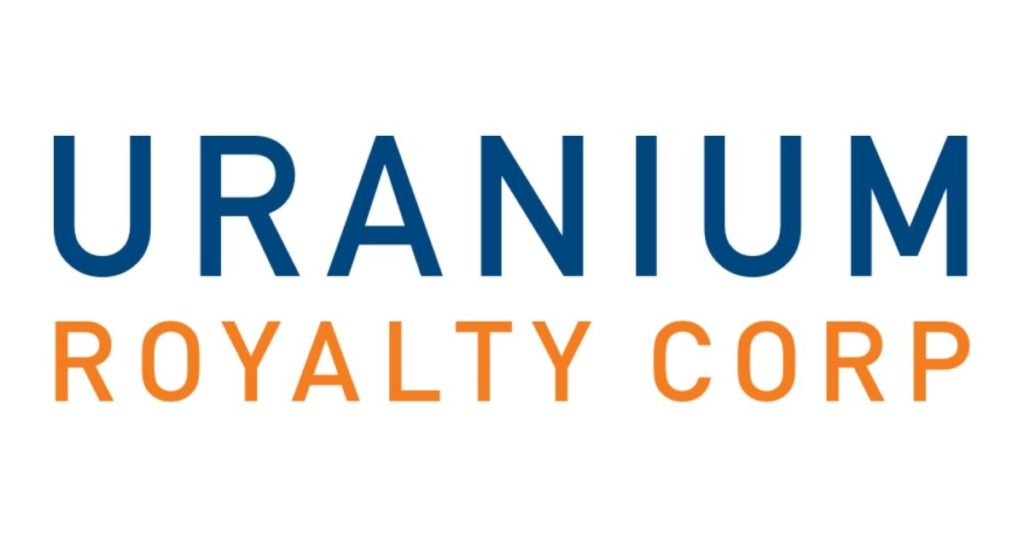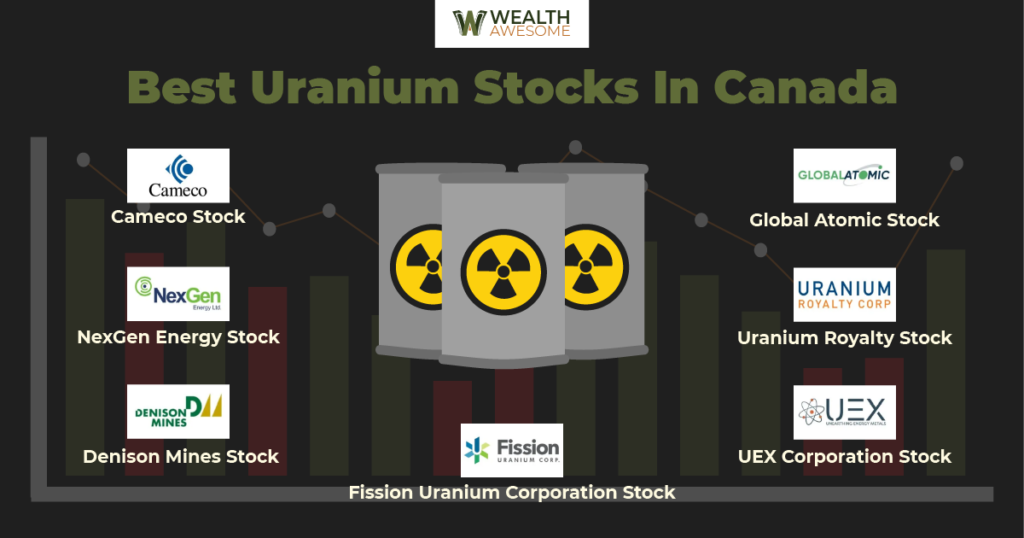Canada is the 39th most populated country in the world, and it produces about 2% of the world’s electricity.
Despite the fact that we have considerable resources and a lot of uranium, nuclear power only makes up about 15% of our power generation resource mix, thanks mostly to our reliance on clean hydropower.
But even if we might not need a lot of uranium for domestic power production, its exports pick up as more countries around the globe start relying on nuclear power as the “transitional energy source” as they move to cleaner renewables.
This is likely to make the best uranium stocks in Canada powerful holdings in the near future.
Uranium – The Future Of Energy
Uranium is an element with significant importance, playing a key role in various aspects of human life and the economy. Even if you take into account the mining and refining process, nuclear power has a minimal carbon footprint. Uranium is also cheaper compared to fossil and most other renewables.
Here’s why uranium is considered to be of great importance:
Nuclear Power Generation:
- Fuel for Nuclear Reactors: Uranium is the primary fuel used in nuclear reactors worldwide. It is fissioned in a nuclear reactor to produce heat, which then generates electricity. Nuclear power plants play a significant role in Canada’s energy sector, providing about 15% of the country’s total electricity generation.
- Energy Security: Uranium-based nuclear power is an alternative to fossil fuels and can enhance energy security and diversity of energy sources.
- Low Greenhouse Gas Emissions: Nuclear power plants emit very low levels of greenhouse gases, contributing to the fight against climate change.
Medical Applications:
- Cancer Treatment: Uranium-derived isotopes like radium and radon are used in certain cancer treatments.
- Medical Imaging: Some uranium derivatives are used in medical diagnostic procedures.
Military Applications:
- Nuclear Weapons: Uranium is used in the production of nuclear weapons, and it plays a role in national defence.
- Depleted Uranium: This is used in some military applications, including armour and munitions, due to its high density.
Scientific Research:
- Understanding Earth’s Age: Uranium-lead dating helps scientists understand the age of the Earth and other geological phenomena.
- Nuclear Research: Uranium is used in many research applications, including physics and engineering studies.
Economic Importance:
- Job Creation: The uranium industry provides jobs in mining, processing, energy generation, and other sectors.
- Export Revenue: For countries rich in uranium resources, uranium export can be a significant source of revenue.
Challenges and Risks:
- Environmental Impact: Uranium mining and processing can have environmental consequences if not managed properly.
- Nuclear Proliferation: The spread of nuclear technology and materials can lead to concerns about nuclear warfare.
- Waste Management: Managing and disposing of nuclear waste, a by-product of using uranium in reactors, is a significant and long-term challenge.
Best Uranium Stocks In Canada
1. Cameco

- Ticker: CCO.TO
- Forward Dividend Yield: N/A
- Upcoming Dividend Date: Dec 15, 2023
- Market Cap: $24.67 Billion
Cameco is among the five largest uranium-producing companies in the world, the largest publicly-owned uranium company, operates in two of the leading uranium-producing countries – Kazakhstan and Canada and has shared ownership of the first and third largest-producing uranium mines in the world.
These credentials cement it as an established leader in the uranium industry. With over 60 years of operations, it has the trust, connections, and access to supply chains, basically everything that’s needed to succeed in such a strictly regulated industry.
Consistency is not a word I would use to define Cameco’s financials, as they are highly attuned to uranium prices and demand. In the last two years, both uranium prices in the international market and Cameco’s revenue have almost doubled.
Interestingly, the stock has appreciated by a similar margin over this period, and it’s not an isolated incident. You can match the pattern of Cameco stock’s performance and uranium prices over the last 25 years with surprising accuracy.
But inconsistency doesn’t mean it’s not financially healthy. It carries a very small amount of debt for a company this size – less than 6% of its current market capitalization. It’s incredibly overvalued at the time of writing this, but it may not cause the stock’s downfall if uranium prices keep climbing.
This uranium price dependency of Cameco stock also means you can buy it as a hedge or outperformer when uranium prices are going up, but the TSX is weak. Between mid-July 2022 and mid-July 2023, the stock went up over 40% compared to the market’s 7.4% climb.
However, you should also remember that it can just as easily go the other way. You may experience a significant decline in your Cameco holdings even if the TSX is bullish.
Factors like global sanctions or nuclear disasters, even if they don’t reach the Chornobyl scale, can introduce a lot of negativity in the market, and giants like Cameco may experience the full brunt of this pessimism (since they are on everyone’s radar).
I would say that the risk is reasonably well-balanced with what Cameco has to offer, but you should make a call about the stock based on your risk tolerance.
2. Sprott Physical Uranium Trust

- Ticker: U-UN.TO
- Forward Dividend Yield: N/A
- Upcoming Dividend Date: Apr 20, 2024
- Market Cap: $7.85 Billion
Sprott Physical Uranium Trust offers an even more direct way to invest in the underlying asset, i.e., uranium. It’s the first of its kind and currently the largest uranium trust in the world, holding over 61 million pounds of uranium.
As a trust, it cannot be evaluated like other uranium companies on this list that extract or process uranium, and its profits are tied to the efficiency of their process (and the price of uranium).
Sprott simply buys and holds uranium. As a result, it benefits from uranium price appreciation and suffers when the price falls.
Sprott is a trusted name in the precious metal industry, and its gold and silver trusts are larger than its uranium trust, so we can confidently say that the company knows what it’s doing.
The physical uranium is held by Cameco and two other companies, and the Management Expense Ratio (MER) charged by Sprott is 0.70%.
The price of the trust follows the price of uranium quite accurately, but there is often a few days, sometimes a few weeks delay, though the long-term pattern remains the same. If the uranium prices fall, the trust price will follow. It’s the same as when the prices go up.
When considering this investment, you have to determine how comfortable you are with direct exposure to uranium (thankfully, not the radioactive kind).
The trust may respond to the uranium price fluctuations much more rapidly than other uranium stocks on this list, so you may have to remain vigilant and active in reacting to negative market trends, especially if you are leveraging short-term upward/downward momentum.
But if you are in it for the long haul, then you only have to focus on predicting whether uranium prices will go significantly up or down five or ten years from now.
3. NexGen Energy

- Ticker: NXE.TO
- Forward Dividend Yield: N/A
- Upcoming Dividend Date: Apr 20, 2024
- Market Cap: $5.29 Billion
NexGen is an exploration and development stage uranium company that is in the process of developing the Rook I project. The idea is that Rook I can emerge as the largest low-cost uranium mine in the world, which is a solid prospect.
It’s predicting an Operational Expense or OPEX per pound of uranium produced at $US 5.69, but that’s merely the projected cost, and the actual number may differ once the production starts.
The Arrow deposit, i.e., the part of Rook I NexGen is set to develop, is expected to produce (as per the feasibility study) 21.7 million pounds of uranium every year for over ten years (mine life).
That’s more than twice the amount Cameco produced in 2022 at a cash cost that’s roughly 2.3 times higher (per pound uranium produced) than the OPEX NexGen is projecting.
Not only is NexGen a promising prospect, but it also carries very little debt, which means it won’t be financially burdened when it starts producing.
But the bad news is that until that fateful day, when its projections meet reality, one of its main sources of raising capital is issuing more shares and diluting the equity of existing investors, though the dilution hasn’t been disproportionately aggressive till now.
It’s highly unlikely that NexGen will miss the mark on its cost of production (per pound), but that’s just one end of the profit; the other end is the uranium price per pound when NextGen starts producing. In this regard, it’s similar to other senior producers like Cameco that are already producing uranium.
If the uranium prices are high, NextGen’s profits may be significantly higher compared to other producers, thanks to its low-cost mining, which will give it a financial edge and help the stock soar.
But even if prices are low, NexGen’s chances of losing money are much lower than a higher-cost producer, which makes NexGen a comparatively safer bet.
You have to make your investment decisions based on two factors: “when” and “if.” When will NexGen start producing, and if its production cost is similar or better than its projections? If production is delayed, the company may have to dilute its shares to generate funds, which will hurt you as an investor.
4. Energy Fuels

- Ticker: EFR.TO
- Forward Dividend Yield: N/A
- Upcoming Dividend Date: Apr 20, 2024
- Market Cap: $1.45 Billion
Energy Fuels is a US-based uranium producer with multiple conventional and in-situ uranium assets. Conventional assets, called uranium mills, have uranium delivered to them where it’s extracted, whereas in-situ projects are uranium mines and processing facilities rolled into one.
Energy Fuels owns the only conventional uranium mill in the US that’s currently functional and has about 8 million pounds of licensed capacity.
If we add all the standby projects, the overall capacity of Energy Fuels is enormous, but based on its existing production contracts (by the next eight years), its yearly output might not even exceed half a million-pound production per year. It also produces other rare metals like vanadium.
Energy Fuels is well-positioned to cater to US uranium needs, especially if more plants come online in the future. It stands out among the producers of similar scale for two reasons: virtually no debt and modest valuation.
Its finances are a bit erratic, to say the least. The revenue has been all over the place in the last two years. The stock price doesn’t chase the uranium price as faithfully as the stock of some other uranium producers, but the pattern is quite similar, especially in the long term.
Thanks to its low valuation, the corresponding stock growth is much more pronounced. An example is the growth between 2020 and 2022 when the stock rose by over 230%.
You should keep in mind that producers like Energy Fuels may rely more on local demand than international demand for uranium. If more nuclear plants start coming online in the US or if existing plants increase their output (though there is little room for that), Energy Fuels may experience an uptick.
But if better renewables lead to the shutdown of a few plants, it may push the stock over the edge.
5. Fission Uranium

- Ticker: FCU.TO
- Forward Dividend Yield: N/A
- Upcoming Dividend Date: Apr 20, 2024
- Market Cap: $929.04 Million
Fission Uranium is an exploration company that is currently in the process of developing its Triple-R uranium deposit. That stands out for two reasons – high-grade and shallow, with certain deposits just 50 meters beneath the surface.
This is a major strength for a future uranium producer, assuming the demand keeps going up and they have a low enough barrier to entry.
The indicated resources are over 110 million pounds of uranium, so even if the company starts with an ambitious production goal of 10 million pounds a year, the reserves are going to last at least a decade.
Despite the fact that it’s not in the production stage yet, the stock is loosely tracking the price pattern of uranium and, consequently, uranium producers and other exploration companies.
However, you should consider the stock’s inherent strengths and weaknesses as well before making a decision.
One financial strength of the company is that it has almost no debt and a decent amount of cash and investments.
But a weakness of the stock is that it appears to be funding its operations through equity dilution. In a decade, the number of its outstanding shares has grown by over 460%.
If you buy now and the pattern continues for the next few years, your holding may be significantly diluted. But you should also keep the potential upside in mind.
As a penny stock, it offers powerful growth during bullish spells that send almost all uranium stocks up, and its lighter weight may be in your favour during such spells as it may climb higher than its larger peers.
6. Ur-Energy

- Ticker: URE.TO
- Forward Dividend Yield: N/A
- Upcoming Dividend Date: Apr 20, 2024
- Market Cap: $638.37 Million
- Forward P/E Ratio: 60
Ur-Energy is another US-based uranium producer that you might consider investing in. It also markets itself as a low-cost producer. However, its numbers till 2019 paint a very different picture.
Its cash cost per pound of uranium produced was almost $24, quite high if you consider the price per pound of uranium in that year.
But you should also look into the other aspects of this business. Its financial position is relatively healthy. There is minimal debt, and its cash reserves are quite significant – Equivalent to 30% of its current market capitalization. The company also has sizable uranium reserves ready to roll out.
If you are considering adding this uranium stock to your portfolio, you should know that what this stock needs to shine is demand.
If there is enough demand in the market for the company to not just release its inventory but also start production at an optimal capacity, the revenues may rise, and the stock might follow.
But you should also keep the flip side in mind. In its current form, a significant price or demand drop may be more damaging to it than other producers that have secured long-term contracts.
The situation may become more dire if more uranium producers enter the market before Ur-Energy has the time to gain traction.
When considering stocks like Ur-Energy, you should look at the big picture. An evaluation of the stock’s strengths and weaknesses is important, but you should also understand how the market is moving so, you have a better idea of how it might impact your investment in a company like Ur-Energy.
7. Uranium Royalty

- Ticker: URC.TO
- Forward Dividend Yield: N/A
- Upcoming Dividend Date: Apr 20, 2024
- Market Cap: $464.70 Million
Uranium Royalty offers investors another different way to gain exposure to the radioactive metal, i.e., royalties. Uranium Royalty is unique as it’s the only pure-play royalty company in the uranium industry, and it has already developed a compelling portfolio.
It has a stake in about 20 uranium projects around the globe (mostly in North America) in several different stages of development and production. Two of the mines it has a stake in are in production, and production has been idled in three of the projects.
On the other end of the spectrum is an early exploration project that may take several years to come online.
The company has already started generating revenue, though it has yet to become cash positive, and that’s with just a small portion of its portfolio in the production stage.
As more projects enter the production stage, the company might experience a significant increase in its revenue and may become cash positive soon.
It has a variety of royalty contracts, including the percentage of Net Profit Income, Net Smelter Return, and Gross Value Royalty, which means that the company will generate royalty income even if the royalty company itself doesn’t turn a profit.
This may allow it to generate (in the long-term) a positive income even when the uranium prices are low. This sets it apart from other uranium stocks on this list.
You should understand that despite the unique strengths of Uranium Royalty (business model, only uranium royalty company), its performance will still be heavily influenced by uranium prices and demand.
It’s less risky and offers you a more “veiled” exposure to uranium, but you cannot expect it to be fully immune to negative trends in the uranium market.
Its small market capitalization is currently in its favour as it may allow you to benefit more from a bullish trend, as evident from its 485% growth in less than two years (between Dec 2019 and Nov 2021).
Related Reading: Best Uranium ETFs In Canada
Can You Invest In Uranium?
Unless you wish to be declared a nuclear terrorist, you shouldn’t look into investing in uranium directly. It’s both illegal and practically impossible to buy uranium anyway. Even between any two countries, uranium is not traded as a commodity or is available for purchase at a commodities exchange.
As a highly radioactive metal, it’s also not something you would want in your backyard (unless it’s made up of thick lead walls).
You can, however, invest in uranium via some of the best uranium stocks Canada has to offer. It’s a relatively small selection, but it is enough to get your portfolio exposure to the radioactive metal that has already changed the world.
Is There Uranium In Canada?
Yes, and a lot of it. Canada is already the second-largest uranium producer in the world and accounts for 13% of the total production. It’s also home to the largest uranium-producing mine (Cigar Lake).
Canadian uranium deposits of high-grade uranium put the country near the top of the list, but Kazakhstan produces much more than Canada.
Kazakhstan, Canada, and Australia dominate the supply of uranium worldwide.
How To Buy Uranium Stocks In Canada
The cheapest way to buy stocks is from discount brokers. My top choices in Canada are:

- 105 commission-free ETFs to buy and sell
- Excellent customer service
- Top-notch market research tools
- Easy-to-use and stable platform

- Stock and ETF buys and sells have $0 trading fees
- Desktop and mobile trading
- Reputable fintech company
- Fractional shares available
To learn more, check out my full breakdown of the best trading platforms in Canada here.
Conclusion

As the world rapidly moves away from fossil, uranium will become even more critical in the energy space, even more so when electric vehicles become more commonplace, and the world needs more clean electricity to move.
The post-crash spike that uranium and associated businesses saw might be a sign of things to come. And if you want this radioactive material to become an asset, you might consider adding its nuclear power to your portfolio in the form of the best uranium stocks in Canada.






How is Denision Mines Understand they are planning a mineing site in northeren Sask.